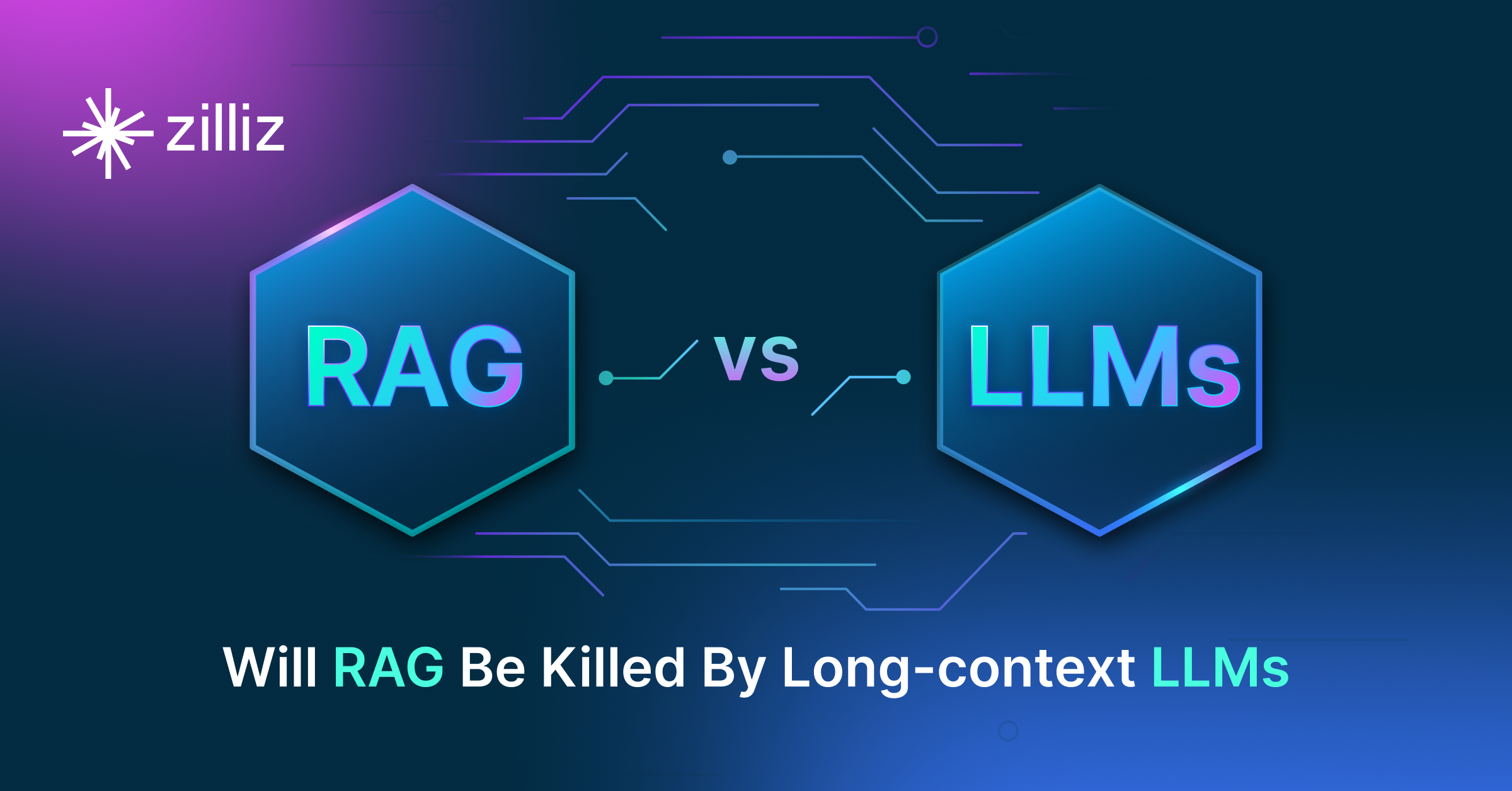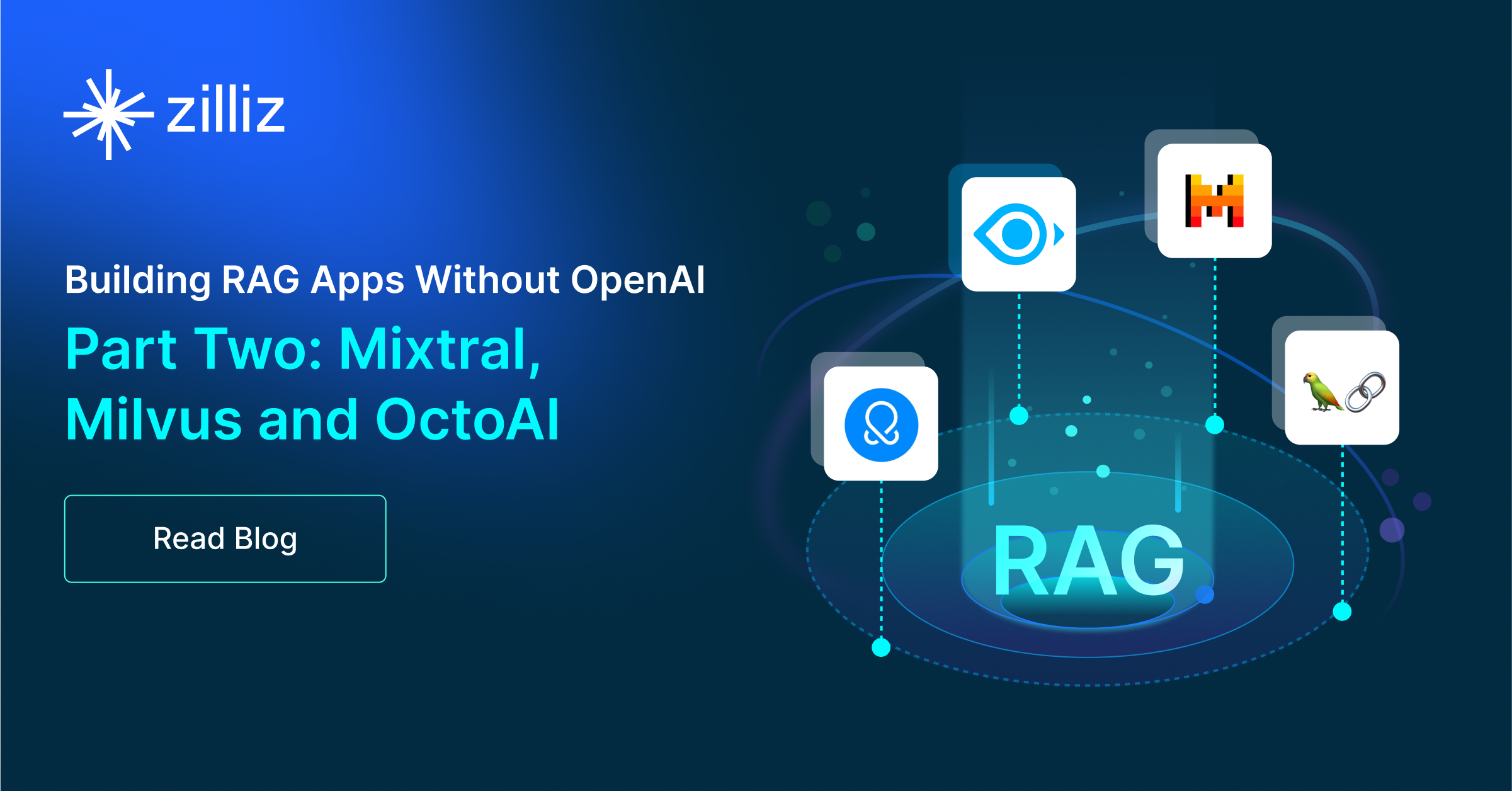Build RAG Chatbot with LangChain, LangChain vector store, Mistral AI Mistral Nemo, and Google Vertex AI textembedding-gecko@003
Introduction to RAG
Retrieval-Augmented Generation (RAG) is a game-changer for GenAI applications, especially in conversational AI. It combines the power of pre-trained large language models (LLMs) like OpenAI’s GPT with external knowledge sources stored in vector databases such as Milvus and Zilliz Cloud, allowing for more accurate, contextually relevant, and up-to-date response generation. A RAG pipeline usually consists of four basic components: a vector database, an embedding model, an LLM, and a framework.
Key Components We'll Use for This RAG Chatbot
This tutorial shows you how to build a simple RAG chatbot in Python using the following components:
- LangChain: An open-source framework that helps you orchestrate the interaction between LLMs, vector stores, embedding models, etc, making it easier to integrate a RAG pipeline.
- LangChain in-memory vector store: an in-memory, ephemeral vector store that stores embeddings in-memory and does an exact, linear search for the most similar embeddings. The default similarity metric is cosine similarity, but can be changed to any of the similarity metrics supported by ml-distance. It is intended for demos and does not yet support ids or deletion. (If you want a much more scalable solution for your apps or even enterprise projects, we recommend using Zilliz Cloud, which is a fully managed vector database service built on the open-source Milvusand offers a free tier supporting up to 1 million vectors.)
- Mistral AI Mistral Nemo: This model is designed for high-performance natural language processing, emphasizing interpretability and adaptability. It excels in tasks involving text generation, dialogue systems, and content creation. Ideal for industries like marketing and entertainment, Mistral Nemo delivers rich, coherent narratives while allowing for fine-tuning to specific domain requirements.
- Google Vertex AI textembedding-gecko@003: This model specializes in generating high-quality text embeddings for diverse applications, including semantic search and content recommendation. It leverages advanced techniques for contextual understanding, ensuring accurate representations of intricate text. Ideal for integration into systems needing scalable and efficient NLP solutions, enhancing user experience in real-time applications.
By the end of this tutorial, you’ll have a functional chatbot capable of answering questions based on a custom knowledge base.
Note: Since we may use proprietary models in our tutorials, make sure you have the required API key beforehand.
Step 1: Install and Set Up LangChain
%pip install --quiet --upgrade langchain-text-splitters langchain-community langgraph
Step 2: Install and Set Up Mistral AI Mistral Nemo
pip install -qU "langchain[mistralai]"
import getpass
import os
if not os.environ.get("MISTRAL_API_KEY"):
os.environ["MISTRAL_API_KEY"] = getpass.getpass("Enter API key for Mistral AI: ")
from langchain.chat_models import init_chat_model
llm = init_chat_model("open-mistral-nemo", model_provider="mistralai")
Step 3: Install and Set Up Google Vertex AI textembedding-gecko@003
pip install -qU langchain-google-vertexai
from langchain_google_vertexai import VertexAIEmbeddings
embeddings = VertexAIEmbeddings(model="textembedding-gecko@003")
Step 4: Install and Set Up LangChain vector store
pip install -qU langchain-core
from langchain_core.vectorstores import InMemoryVectorStore
vector_store = InMemoryVectorStore(embeddings)
Step 5: Build a RAG Chatbot
Now that you’ve set up all components, let’s start to build a simple chatbot. We’ll use the Milvus introduction doc as a private knowledge base. You can replace it with your own dataset to customize your RAG chatbot.
import bs4
from langchain import hub
from langchain_community.document_loaders import WebBaseLoader
from langchain_core.documents import Document
from langchain_text_splitters import RecursiveCharacterTextSplitter
from langgraph.graph import START, StateGraph
from typing_extensions import List, TypedDict
# Load and chunk contents of the blog
loader = WebBaseLoader(
web_paths=("https://milvus.io/docs/overview.md",),
bs_kwargs=dict(
parse_only=bs4.SoupStrainer(
class_=("doc-style doc-post-content")
)
),
)
docs = loader.load()
text_splitter = RecursiveCharacterTextSplitter(chunk_size=1000, chunk_overlap=200)
all_splits = text_splitter.split_documents(docs)
# Index chunks
_ = vector_store.add_documents(documents=all_splits)
# Define prompt for question-answering
prompt = hub.pull("rlm/rag-prompt")
# Define state for application
class State(TypedDict):
question: str
context: List[Document]
answer: str
# Define application steps
def retrieve(state: State):
retrieved_docs = vector_store.similarity_search(state["question"])
return {"context": retrieved_docs}
def generate(state: State):
docs_content = "\n\n".join(doc.page_content for doc in state["context"])
messages = prompt.invoke({"question": state["question"], "context": docs_content})
response = llm.invoke(messages)
return {"answer": response.content}
# Compile application and test
graph_builder = StateGraph(State).add_sequence([retrieve, generate])
graph_builder.add_edge(START, "retrieve")
graph = graph_builder.compile()
Test the Chatbot
Yeah! You've built your own chatbot. Let's ask the chatbot a question.
response = graph.invoke({"question": "What data types does Milvus support?"})
print(response["answer"])
Example Output
Milvus supports various data types including sparse vectors, binary vectors, JSON, and arrays. Additionally, it handles common numerical and character types, making it versatile for different data modeling needs. This allows users to manage unstructured or multi-modal data efficiently.
Optimization Tips
As you build your RAG system, optimization is key to ensuring peak performance and efficiency. While setting up the components is an essential first step, fine-tuning each one will help you create a solution that works even better and scales seamlessly. In this section, we’ll share some practical tips for optimizing all these components, giving you the edge to build smarter, faster, and more responsive RAG applications.
LangChain optimization tips
To optimize LangChain, focus on minimizing redundant operations in your workflow by structuring your chains and agents efficiently. Use caching to avoid repeated computations, speeding up your system, and experiment with modular design to ensure that components like models or databases can be easily swapped out. This will provide both flexibility and efficiency, allowing you to quickly scale your system without unnecessary delays or complications.
LangChain in-memory vector store optimization tips
LangChain in-memory vector store is just an ephemeral vector store that stores embeddings in-memory and does an exact, linear search for the most similar embeddings. It has very limited features and is only intended for demos. If you plan to build a functional or even production-level solution, we recommend using Zilliz Cloud, which is a fully managed vector database service built on the open-source Milvus and offers a free tier supporting up to 1 million vectors.)
Mistral AI Mistral Nemo optimization tips
Mistral Nemo is designed for domain-specific knowledge retrieval and response generation, making retrieval efficiency a top priority. Optimize performance by fine-tuning retrieval pipelines to ensure domain-relevant embeddings are used for similarity searches. Use a ranking layer to prioritize the most contextually relevant passages before passing them to the model, reducing token waste. Adjust temperature settings (0.1–0.3) to maintain consistent, structured responses. In latency-sensitive applications, use token streaming to provide incremental responses rather than waiting for full completion. If running Nemo in a production environment, consider distributed inference techniques to manage large-scale workloads effectively. Monitor retrieval accuracy continuously and fine-tune embeddings periodically to keep responses aligned with domain-specific updates.
Google Vertex AI textembedding-gecko@003 optimization tips
Google Vertex AI textembedding-gecko@003 is designed for advanced text understanding, making it ideal for high-accuracy RAG applications. Optimize embedding generation by removing noisy data and focusing on the most relevant content within documents. Use efficient vector search algorithms, such as FAISS with IVF or HNSW, to ensure fast and accurate document retrieval. Batch text embeddings for large volumes of data to speed up processing and minimize latency. Implement caching for high-frequency queries and periodically refresh embeddings to keep up with changes in the data landscape. Fine-tune the model on domain-specific tasks to improve relevance in specialized RAG applications. Consider deploying a multi-stage search strategy with semantic and keyword-based approaches for optimal accuracy and performance.
By implementing these tips across your components, you'll be able to enhance the performance and functionality of your RAG system, ensuring it’s optimized for both speed and accuracy. Keep testing, iterating, and refining your setup to stay ahead in the ever-evolving world of AI development.
RAG Cost Calculator: A Free Tool to Calculate Your Cost in Seconds
Estimating the cost of a Retrieval-Augmented Generation (RAG) pipeline involves analyzing expenses across vector storage, compute resources, and API usage. Key cost drivers include vector database queries, embedding generation, and LLM inference.
RAG Cost Calculator is a free tool that quickly estimates the cost of building a RAG pipeline, including chunking, embedding, vector storage/search, and LLM generation. It also helps you identify cost-saving opportunities and achieve up to 10x cost reduction on vector databases with the serverless option.
 Calculate your RAG cost
Calculate your RAG cost
What Have You Learned?
What Have You Learned?
Congratulations on completing this tutorial! You've just unlocked the incredible potential of a cutting-edge RAG (Retrieval-Augmented Generation) system by integrating four essential components: a robust framework, a powerful vector database, an intelligent LLM, and an insightful embedding model. Isn’t it amazing how the LangChain framework ties everything together, providing seamless connections and workflows? You've seen how the vector database enables lightning-fast searches, allowing you to retrieve information in an instant, even when dealing with vast amounts of data.
With the Mistral AI LLM on your side, you can harness the latest in conversational intelligence, generating responses that are engaging and relevant. And don’t forget about the embedding model that you’ve learned to use, which crafts rich semantic representations of your data, ensuring that your RAG system understands context like never before. Plus, the optimization tips and the free cost calculator included in the tutorial are fantastic resources to help you streamline your projects and manage your resources effectively.
Now that you have this robust toolkit, the sky's the limit! I encourage you to dive in, explore, and start building your own RAG applications. Test out new ideas, innovate, and most importantly, have fun with it. The world of AI is at your fingertips, and it’s time to make your unique mark in this exciting landscape! Happy building!
Further Resources
🌟 In addition to this RAG tutorial, unleash your full potential with these incredible resources to level up your RAG skills.
- How to Build a Multimodal RAG | Documentation
- How to Enhance the Performance of Your RAG Pipeline
- Graph RAG with Milvus | Documentation
- How to Evaluate RAG Applications - Zilliz Learn
- Generative AI Resource Hub | Zilliz
We'd Love to Hear What You Think!
We’d love to hear your thoughts! 🌟 Leave your questions or comments below or join our vibrant Milvus Discord community to share your experiences, ask questions, or connect with thousands of AI enthusiasts. Your journey matters to us!
If you like this tutorial, show your support by giving our Milvus GitHub repo a star ⭐—it means the world to us and inspires us to keep creating! 💖
- Introduction to RAG
- Key Components We'll Use for This RAG Chatbot
- Step 1: Install and Set Up LangChain
- Step 2: Install and Set Up Mistral AI Mistral Nemo
- Step 3: Install and Set Up Google Vertex AI textembedding-gecko@003
- Step 4: Install and Set Up LangChain vector store
- Step 5: Build a RAG Chatbot
- Optimization Tips
- RAG Cost Calculator: A Free Tool to Calculate Your Cost in Seconds
- What Have You Learned?
- Further Resources
- We'd Love to Hear What You Think!
Content
Vector Database at Scale
Zilliz Cloud is a fully-managed vector database built for scale, perfect for your RAG apps.
Try Zilliz Cloud for Free


